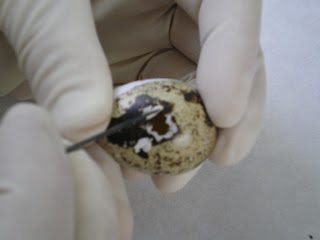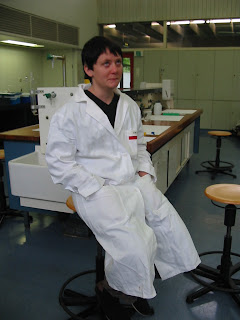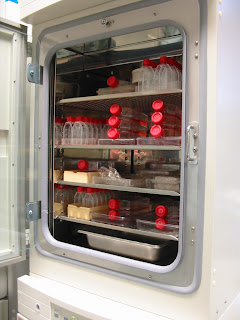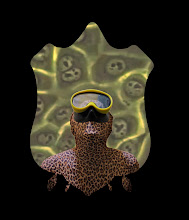June 29 - 8:30 Test Day
July 1 - Design 24 well plates with coloured acetate (x3)
July 9 - 13:00 Autoclave Army Men
Autoclave 24 well plates
Seed 24 well plates with HIV infected he_la cells
Soak Army Men in Collagen overnight
July 10 - Seed Army Men with he_la cells
July 13 - Check virus growth in 24 well plates
Check cell growth on Army men
Infect he_la cells on Army Men with HIV virus
July 16 - Transfect army men with blue stain
Document finished objects
Fix Cells
Remove tissue and sterilise men to take back to OZ
STAGE 1 OF PROJECT COMPLETE
July 17 - Aug 28 Vietnam exhibition The Last Vestige
October onwards - get together with Eden to make video piece and work on developing still imagery also.
2008 - Apply to exhibit work in IMA and Gertrude Street
Saturday 30 June 2007
Project Test Day with blue staining technique
Fri 29th June we headed out to Vrij University at a ghastly 7:30am to meet Lot de Witte in the Lab for a test run of the blue staining technique.

Early morning happiness...


Preparing the stain beforehand in a PC2 Lab.


Entering the AIDS Lab. BLS3 Security.

Checking out he_la cells pre-enzyme.

Washing with PBS Solution.


Staining the he_la cells with the enzyme.

Into the incubator for 2 hours.
After incubating the cells for 1 hour we checked them for visibility and the result was not very encouraging. Although we could see the blue stain very clearly in the infected cells, we could see nothing with the naked eye. Upon checking another hour later though the cells had proliferated rapidly and we could easily see the infected cells in the daylight, without the need for the microscope. Next week when we do this on the he_la cultured army guys we will extend the incubation period and hopefully the cels will proliferate more creating a stronger colour.

After 2 hours incubation the infected cells can be clearly seen in blue.


This is one of the army figurines we will be culturing he_la over and infecting with the HIV virus. Testing the possibility of viewing cells directly from the army mens bodies, but no luck...

Soldier silhouettes we will be using as acetate backdrops for animation piece.
Methodology:
The he_la cells were infected with the HIV virus two days prior to the test.
The cells were seeded in one 24 well plate.
Colouration:
Remove medium and add 1 ml of fixing solution (1% formeldehyde, 0.2% glutaraldehyde in PBS) per well for 10 mins at RT (no more than 10 min). Remove fixer and wash twice with PBS. Add staining solution (0.25 mls for 24 well plate, 0.5 ml for 12 well plate) to cells and leave at 37 degrees Celcius. Incubate the plate 2Hr (minimum, we can incubate ON at RT in the dark). The staining reaction is tsopped by washing the plates twice with PBS.
Staining solution should be fresh each time.
For 1 ml
950 microliters PBS
20 microlitres- 0.2 M, Potassium Ferrocyanide
20 microlitres- 0.2 M, Potassium Ferricyanide
10microlitres - 2 M, MgC12
10 microlitres - 40mg/ml X-Gal (make up X-Gal in DMSO and store at -20 degrees Celcius in small aliquots that are protected from the light. The X-Gal stocks will turn yellow over time. This will not affect the assay. Throw away the stocks if the yellow colour turns greenish-brown).
----------------------------------------
To see the virus's growth happen so rapidly was pretty amazing. It really hit home to me just how aggressive this organism is.
It felt really strange to be infecting Henrietta's cells with HIV. Knowing how her family feels about the mass existance of her cells, and what happenined to her makes me feel very uneasy to be using them for this purpose - but, I do feel we are using them for a positive cause, to promote issues relating to those living with HIV, and the phenomenon itself.
In the time that i've spent with her cells and her story, i've come to equate her cell with her body and thus, herself. I guess if you equate tissue with embodied existance, and you consider the massive quantities of her cell line that exist internationally, and all of the various purposes it has been used for, she is in effect a woman who has lived a thousand different lives.

Early morning happiness...


Preparing the stain beforehand in a PC2 Lab.


Entering the AIDS Lab. BLS3 Security.

Checking out he_la cells pre-enzyme.

Washing with PBS Solution.


Staining the he_la cells with the enzyme.

Into the incubator for 2 hours.
After incubating the cells for 1 hour we checked them for visibility and the result was not very encouraging. Although we could see the blue stain very clearly in the infected cells, we could see nothing with the naked eye. Upon checking another hour later though the cells had proliferated rapidly and we could easily see the infected cells in the daylight, without the need for the microscope. Next week when we do this on the he_la cultured army guys we will extend the incubation period and hopefully the cels will proliferate more creating a stronger colour.

After 2 hours incubation the infected cells can be clearly seen in blue.


This is one of the army figurines we will be culturing he_la over and infecting with the HIV virus. Testing the possibility of viewing cells directly from the army mens bodies, but no luck...

Soldier silhouettes we will be using as acetate backdrops for animation piece.
Methodology:
The he_la cells were infected with the HIV virus two days prior to the test.
The cells were seeded in one 24 well plate.
Colouration:
Remove medium and add 1 ml of fixing solution (1% formeldehyde, 0.2% glutaraldehyde in PBS) per well for 10 mins at RT (no more than 10 min). Remove fixer and wash twice with PBS. Add staining solution (0.25 mls for 24 well plate, 0.5 ml for 12 well plate) to cells and leave at 37 degrees Celcius. Incubate the plate 2Hr (minimum, we can incubate ON at RT in the dark). The staining reaction is tsopped by washing the plates twice with PBS.
Staining solution should be fresh each time.
For 1 ml
950 microliters PBS
20 microlitres- 0.2 M, Potassium Ferrocyanide
20 microlitres- 0.2 M, Potassium Ferricyanide
10microlitres - 2 M, MgC12
10 microlitres - 40mg/ml X-Gal (make up X-Gal in DMSO and store at -20 degrees Celcius in small aliquots that are protected from the light. The X-Gal stocks will turn yellow over time. This will not affect the assay. Throw away the stocks if the yellow colour turns greenish-brown).
----------------------------------------
To see the virus's growth happen so rapidly was pretty amazing. It really hit home to me just how aggressive this organism is.
It felt really strange to be infecting Henrietta's cells with HIV. Knowing how her family feels about the mass existance of her cells, and what happenined to her makes me feel very uneasy to be using them for this purpose - but, I do feel we are using them for a positive cause, to promote issues relating to those living with HIV, and the phenomenon itself.
In the time that i've spent with her cells and her story, i've come to equate her cell with her body and thus, herself. I guess if you equate tissue with embodied existance, and you consider the massive quantities of her cell line that exist internationally, and all of the various purposes it has been used for, she is in effect a woman who has lived a thousand different lives.
HIV Project - Staining technique

After much time and energy spent trying to locate a Darkreader transilluminator, or something similar from amny different sources, some of whom had never even heard of one, it was decided that we'd try an alternative technique for cell visualisation, with a blue coloured enzyme which infiltrates infected cells and can be seen with the naked eye. This is a great alternative, as we don't have to worry about locating any new equipment etc as we would with GFP cells, and can take photographic imagery in daylight. Ive never done it before either, so I'm curious to see just how visible the cells will be.
We have our methodology and an appointment for the 29th June, so we are set to go!
Wednesday 27 June 2007
HIV Project Update


Ok today we recieved confirmation from Vrij Uni that we can go ahead with the project, so we are Very Excited!
We will be using he_la cells to culture over glass army figurines, as that is a technique i'm familiar with. There are two options we can go with for the visualisation of the infected cells. The first is to use a blue enzyme which can be seen in daylight with the naked eye. As Lot has not used this technique before she would prefer not to, unless necessary. The second and more favourable option to use is GFP he_la's. To visualise the infected he_la cells effecively however we need to access a transilluminator such as a Darkreader, rather than a straight UV light, which enhances the flourescence substantially, otherwise they will be quite difficult to see, as GFP expression in HIV is quite low. Above is what the Darkreader can do, so it seems to be quite a significant difference.
So right now we are trying to locate a transilluminator which can do this...
Sunday 10 June 2007
A&G Centre Lot de Witte - Meeting #2
Tuesday 5th of June was the the second meeting with Lot de Witte. In the previous meeting with her she implied that it may be possible to actually work with the HIV virus itself - to tissue culture it over 3D glass form, in the Vrij University Immunology Labs. This is really exciting, and in preparation we are organising two small glass army figurines to be ready within a couple of weeks. This meeting with Lot confirmed the possibility of carrying out the project at Vrij, however it has to be cleared with the Dept etc, and it will be Lot who physically works with the virus itself, while we document the process. This is as expected due to the Biological Safety Level required to work with an incurable virus such as HIV/AIDS.
So right now we are waiting to hear back from the Dept, as to whether it gets the go-ahead or not...
So right now we are waiting to hear back from the Dept, as to whether it gets the go-ahead or not...
Sunday 27 May 2007
A&G Centre HIV Project 4 - Prof Ben Berkhout
A few days after meeting with Prof Berkout I sent a follow up email confirming my interest in the possibility of working with some T-Cells in the Laboratory. As I expected, he replied to say that as they did not have the specific cells I was wanting to work with, nor the time and space to give me the appropriate training to work in their Labs that he was unable to provide me with Lab access.
The hunt continues...
The hunt continues...
A&G Centre: Micro-surgery 101
























May 11 2007: Adam Zaretsky Embryology Session, Leiden University.
Eden St James was kind enough to photograph the experience.
I was assigned a phesant egg, with a three day old embryo inside. This egg had a name. It was called material.
Rationale: Perform micro-surgery on the embryo, using
a)Microsurgical tools to modify the form
b)acid to modify the growth
c) growth mutating plasmid
I chose micro-surgical tools only.
The idea of performing Micro-surgery on an embryo really made me feel physically ill. I was struggling with the idea of going through with it, and very nearly didn't. So I felt as someone who inadvertently uses animal products in a Lab, even when I am growing tissue, I should address the fact of this head on and actively engage with and take responsibility for it, instead of just ignoring it,or putting it down to necessity as I suppose I have been doing. Its very easy to sideline it if its a generic coloured liquid in a generic coloured bottle - not so when its actally an animal form. Bio-tech is really scary. Exciting and horrible at the same time. As I began the process of locating and positioning the embryo, opening the 'window' in the egg shell and creating my micro-surgical glass tools I felt all my emotions - adrenelan/intrigue/excitement/power/fantasy all conflicting inside me, and overall the excitiment overcame the hesitation. The experience was very powerful and the act of being there in that moment really overtook from my conceptualising about what I was actually doing, and why. It was such a rush, like wow, creating a new life form - I can really understand how ethics goes out the window. I think its like that often with wet science, you lose track of yourself amongst the labcoat and coloured bottles and material and this idea of engaging with 'life' or creation takes over.
I think also because the embryo was only three days old when you view it inside the egg, even under the microscope, its very hard to tell what you are looking at, which makes the disassociation stronger.
In the end though i really did feel i'll, and topped the whole experience off by going outside and eating a boiled chicken egg I had brought with me. Sophie also took a video of me doing this. It was really unplesant.
I'm glad I did it though. It reminds me to keep engaged with what i'm doing and working with, to keep a check on my self and to be aware of the lures of the Lab-lust; to keep questioning and reminding myself what my goal is in working in this realm anyhow.
On the flip side, it turned out to be a little SymbioticA reunion, as Shawn and Jen from Bioteknica turned up, and Cynthia Verspaget and her Adam dropped in on their way from the Portugal Bioart show, all of whom were at Symbi when I was there. Random goodness!
Sex postitve performance artists Zootengenant (http://www.zootengenant.com) also came along to film the class. They had requested we all bring a sperm sample to class, and were going to do a performance in which Jeanette would do a handstand naked while Zoot levitated eggs with insense, but needless to say there was no levitation, so instead Jeanette gave Adam a sperm-horoscope reading. So the class also had some other happenings happening, beginning with one of the students taking magic mushrooms as an 'assignment', and a bunch of the students leaving to masturbate as ve=arious points, to produce the sperm sample, while Jeanette videotaped them.
Monday 14 May 2007
A&G Centre HIV Project - Lot de Witte

Tuesday 15 May Eden and I met with Lot de Witte, a PhD researcher at the Vrije University's Medical Centre (VUMC). After a lot of fooling around with directions (as I seem to be experiencing a lot in this counrty) we arrived 1 hour late and had to reschedule to the next afternoon. When we finally met Lot was very forward in asking us what we were wnting from the project, and was extremely helpful in providing us with a lot of information and visual imagery of the virus.
A&G Centre - Zoo visit and animal enrichment installation - Adam Zaretsky





On May 4th I was invited to join Adam Zaretsky's class on their visit to the Amsterdam Zoo (Artis). Zaretsky is an American Bioartist who I met last year at the SLSA Conference in Amsterdam, who is here as guest lecturer at the A&G Centre for 6 weeks. He's giving his Vivoarts class, which delves into Ecology and EcoArt, Gastronomy and Edible Art, Biology and Bio-Art,
Ethology and Art for Non-humans, Physiology and Body Art and involves a couple of hands on Lab classes. So I think i'll tag along on next weeks class too...
First we had a lecture by one of their P.R people/staff on animal life in the zoo and a little on their animal enrichment strategies, which were really surprisingly poor and unimaginative. I don't know how many Zoos have an animal enrichment program - maybe it's quite a new thing, but I really don't see how throwing a road works witch's hat into the polar bear pen counts as a legitimate form of animal enrichment! I think they seriously need some creative people on their team. We also got to go behind the scenes with one of the zookeepers, and see the little concrete pens where the animals sleep, as well as see their freezers full of a whole assortment of frozen animals (food). It was like a cross between a butchers and a museum in there - so many different kinds of rodents etc...as well as skinned things like chickens. Mostly the tigers just live off a whole cow carcass which is thrown in the pen every three days.
The focus of the class was really on animal enrichment, so our main activity was to create a contraption from bunji cord and random animal toys etc, including a trampoline, that could go into one of the animal enclosures for the nanimals to play with - see below. I think we kind of freaked out the zoo staff, and they didn't put the crazy contraption into any enclosure, but they said they'd modify it and get back to us....Hah. I wonder.
A&G Centre HIV Project 3. Prof Ben Berkhout: AMC AIDS Laboratories






Wednesday 25th of April I had a meeting with Prof Ben Berkhout at the University of Amsterdam's Medical Centre (AMC), Immunology Department.
Berkhout is a molecular biologist working directly with the complete HIV virus, unlike many researchers who may actually deal with only one component of the virus such as a particular protein etc. He gave me some up to date information on the innovative research they are doing on the virus using a live virus as a vaccine. They have developed a virus which can be turned on and off by using an antibiotic as a trigger. They'll be testing this on macaws in the near future. He also showed me some recent research on the visulaisation of the virus, a couple of websites: www.nature.com/nature/journal/v441/n7095/full/nature04817.html
They have deciphered the shape of a particular protein in HIV 1 which takes on the stable form of a tripod like structure. It interesting to find out that they do not even know what the virus itself really looks like internally, and this kind of visual research is still somewhat in its infancy, due to the minute size of the virus itself.
I was also lucky enough to gain access to their BSL3 (Biological Safety Level 3) Aids Lab. Rienk Jeeninga (pictured) gave me the tour.
Subscribe to:
Posts (Atom)
